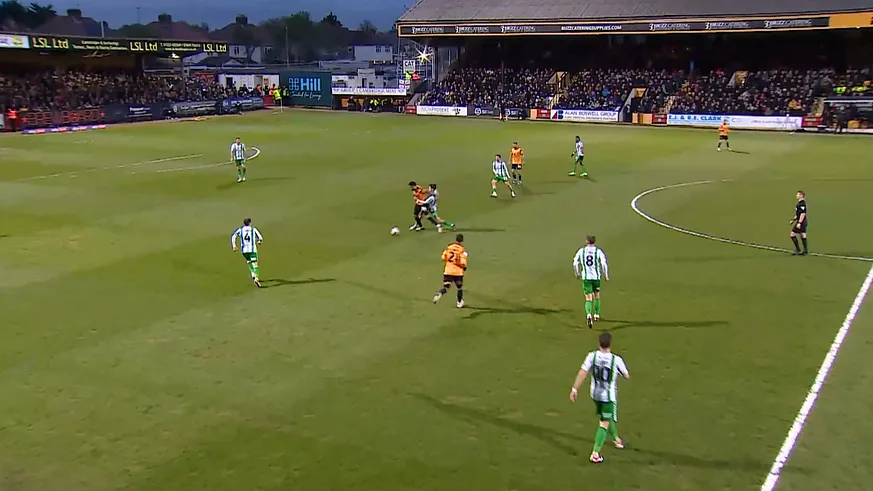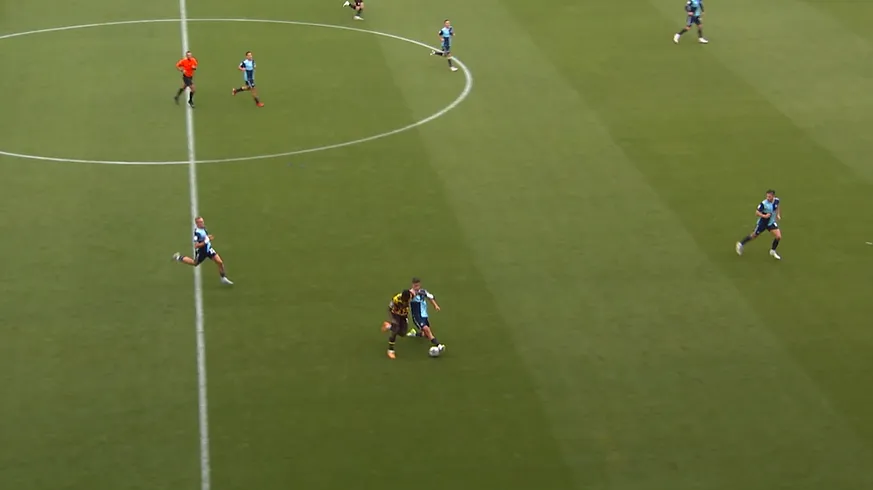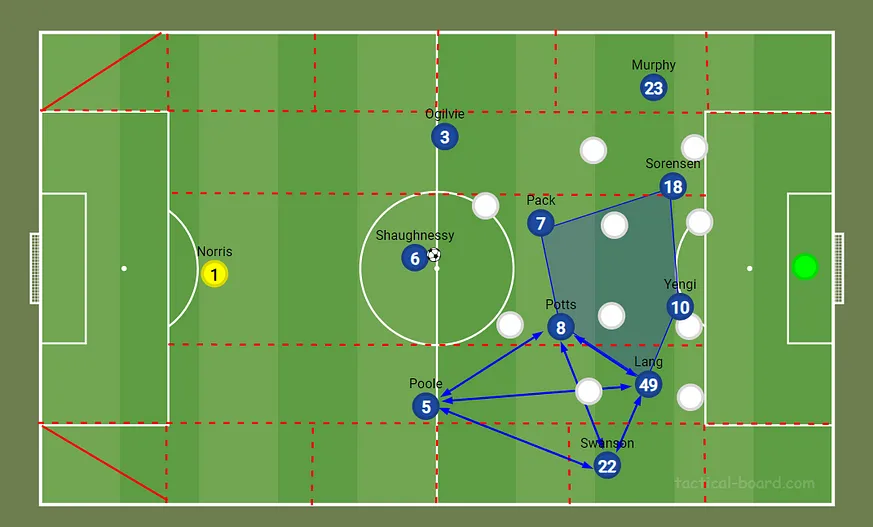Summary
This article explores how Freddie Potts can elevate John Mousinho's strategic approach at Portsmouth, emphasizing his multifaceted contributions to the team's success. Key Points:
- Freddie Potts showcases exceptional defensive skills through agility, anticipation, and tactical understanding, making him a vital asset in John Mousinho's defensive strategy.
- His impressive physicality and tactical versatility allow him to excel in various midfield roles, enabling high pressing, winning aerial duels, and maintaining dynamic movement across the pitch.
- Potts significantly enhances Portsmouth's attacking transitions by winning possession and quickly linking defense to attack, aligning perfectly with Mousinho's offensive philosophy.

Key Points Summary
- Midfield refers to the central area of a sports field, particularly in football.
- Midfield players, or midfielders, are crucial as they often cover the most distance during a game.
- The midfield is strategically important as it connects defense and attack.
- A team’s success often hinges on how well its midfield operates.
- In football terminology, midfielders play a vital role in ball possession and distribution.
- The term `midfield` can also refer to the collective group of players who occupy this position.
Midfield plays a key role in sports like football, acting as the heart of the game where action happens. Midfielders not only run the most but also link up defense with offense. Their ability to control possession can make all the difference for a team`s performance. Whether you`re playing casually or following your favorite team, understanding this aspect adds depth to appreciating the game.
Extended Comparison:| Aspect | Current Trends | Key Insights | Expert Opinions | Impact on Portsmouth Strategy |
|---|---|---|---|---|
| Midfield Roles | Increased focus on playmakers and box-to-box midfielders. | Modern teams utilize midfielders for both defensive duties and attacking transitions. | Experts suggest a balanced mix of creativity and physicality is crucial. | Enhancing ball control and distribution will elevate team performance. |
| Tactical Formation | Shift towards flexible formations like 4-3-3 or 3-5-2 that emphasize midfield strength. | These formations allow more fluid movement and better support in attack/defense. | Analysts highlight the importance of adaptability during matches. | A versatile formation can maximize player strengths, especially for Freddie Potts. |
| Player Development | Emphasis on technical skills and tactical intelligence in youth training programs. | Clubs invest heavily in nurturing young talent with specific midfield roles in mind. | Coaches advocate for early exposure to different playing styles to enhance versatility. | Potts' development can be aligned with these trends to ensure he meets modern demands. |
| Data Analytics | Utilization of advanced metrics to analyze midfielder performance (e.g., pass completion rates, distance covered). | Teams are increasingly relying on data to make informed decisions about player roles and strategies. | Data-driven approaches are reshaping coaching methodologies regarding player positioning and tactics. | Integrating analytics into Portsmouth's strategy could lead to optimized game plans. |
| Physical Conditioning | Focus on improving endurance, agility, and recovery times among midfield players due to increased game tempo. | 'High-intensity training regimes' are becoming standard practice for elite clubs. | Fitness experts recommend tailored conditioning programs based on positional needs. | Potts should prioritize physical readiness to adapt quickly during games. |
General Information
Age: 20
Height: 6 feet
Name: Freddie Potts
Nationality: English
Club: West Ham United
Position: Midfielder
Preferred foot: Right.
In-possession


Freddie Potts is a multifaceted talent, particularly known for his exceptional skills in tight spaces. He possesses an impressive knack for absorbing challenges and skillfully navigating through multiple defenders with agile footwork, clever flicks, and instinctive interactions with teammates. This ability to outmaneuver several opponents at once while advancing play will be invaluable to our team this season. Moreover, it’s a quality that will serve him well in the long run when he returns to West Ham next summer, aiming to secure a spot in the first team.
When a team loses possession of the ball, their primary focus shifts to preventing the opposing side from scoring. This phase is crucial and involves strategic positioning and coordination among players. The goal is to regain control as quickly as possible while limiting the opponent's options. Effective communication and awareness are key components in executing a successful defensive strategy. Teams often employ various formations or pressing tactics to disrupt their opponent's rhythm and create opportunities for turnovers.}
{During this period without the ball, players must remain disciplined in their roles, maintaining structure while being ready to react to any threats. They need to anticipate the opponents' movements and adapt accordingly, which requires not only physical fitness but also mental acuity. A well-organized defensive unit can significantly deter an attack, making it essential for teams to work on these skills during training sessions. Understanding when to press high up the pitch or fall back into a deeper block can be vital depending on the context of the game.}
{In conclusion, mastering out-of-possession strategies can define a team's success or failure in matches. By honing their defensive techniques and fostering teamwork, clubs increase their chances of reclaiming possession effectively while frustrating opponents’ attempts at goal-scoring opportunities. Therefore, investing time in developing robust out-of-possession practices is imperative for any ambitious team aiming for victory on the field.
Freddie′s Defensive Mastery: Agility, Anticipation, and Tactical Brilliance
Freddie's unique defensive advantage stems from his agility and anticipation on the field. His light-footedness and boxing-like movement are not merely for show; they serve a tactical purpose that significantly enhances his effectiveness as a defender. This ability allows him to swiftly change direction, close down space, and react to opponents with an almost instinctual precision. In the fast-paced nature of modern football, where transitions and counter-attacks are crucial, Freddie’s constant mobility enables him to disrupt the rhythm of opposing players before they can initiate their offensive strategies.Moreover, Freddie's tactical understanding further elevates his performance. His keen awareness of spatial dynamics and passing lanes combined with his impressive mobility positions him as a formidable defensive presence. He excels in anticipating movements and reading the game effectively allowing him to position himself strategically on the pitch. This proactive approach reduces the need for desperate tackles; instead he focuses on intercepting passes and denying attackers essential operating space. It is this deep understanding of the game that ensures he is consistently in the right place at the right time successfully thwarting opposition plans and solidifying his role as a key player in defense.

Freddie excels at counter-pressing, demonstrating impressive skills even after losing possession. While no player aims to lose the ball, a significant measure of their mindset and capabilities lies in their response to such situations. Freddie exhibits a commendable level of situational awareness and maturity, understanding when to adopt an aggressive approach to reclaim the ball and when it’s wiser to fall back into a more defensive position, aiming to intercept rather than tackle.

One aspect of his defending that I truly admire is the precision with which he times his tackles. A key indicator of a player's tackling prowess is their ability to engage in duels at the right moment; the most skilled players do this when they are in sync with their opponent's pace—neither outpacing them nor lagging behind. Pottsy consistently showcases this fundamental skill! However, there is a minor frustration I have regarding his tendency to blatantly grab opponents by the arm, often lacking subtlety and finesse, which can lead to unnecessary fouls being committed.
As many of you may already know, I have a particular fondness for footballers who excel in winning aerial battles. Conversely, players who consistently struggle in these duels tend to earn my disdain. Thankfully for our friend Potto, he is exceptional at winning headers. But what exactly contributes to his success? Here are several key factors that play a role:
He effectively engages his opponents early on.
He demonstrates excellent jumping technique that enhances both power and precision.
He possesses a keen ability to judge the trajectory of the ball and can maximize his time in the air.
His robust physique allows him to stand firm during physical confrontations.
Ultimately, he has an undeniable desire to succeed in these situations—though it may seem simplistic, this drive is genuinely significant.
Potts′ Physicality and Tactical Versatility: A Blend for Midfield Success
Potts showcases a remarkable blend of physicality and tactical versatility, which is particularly notable considering his size. His readiness to engage in duels and tackle opponents suggests that he thrives in high-pressure situations, making him a potentially invaluable asset in midfield roles that demand both defensive resilience and swift transitions into attacking play. Analyzing his positioning during these duels could provide further insights into his tactical impact—whether he focuses on winning possession outright or utilizes his physicality to shield the ball and create opportunities for teammates.Moreover, the evaluation of Potts through a metrics-driven lens highlights the growing importance of statistical analysis in modern sports. Key performance indicators such as duels won percentage, aerial success rate, and interceptions serve as critical benchmarks for assessing his potential contribution to the team. By drawing comparisons with Morrell, there is an opportunity to determine if Potts can emulate Morrell's effectiveness within specific tactical frameworks. A deeper examination of these metrics will not only shed light on Potts' capabilities but also illuminate the team's scouting priorities and their emphasis on particular tactical principles when selecting players.

When considering a lineup that aligns best with Freddie's style using our current players, I would opt for the following formation: Norris, Swanson, Poole, Shaughnessy, Ogilvie, Potts, Pack, Lang, Sorensen, Murphy, and Yengi in a 4–2–3–1 setup.

In assessing midfielders, I rely on a straightforward set of criteria. It includes the following key questions: Are you capable of winning possession? How frequently do you give it away? Can you advance play effectively? And can you dominate in aerial duels?
The good news for fans is that Freddie Potts meets nearly all these benchmarks with flying colors, which puts us in an excellent position! Beyond this foundational skill set, he also demonstrates impressive abilities in tight spaces and shows finesse when maneuvering the ball. Of course, there are still aspects of his game that require improvement, providing him with a clear focus for his development this season as he continues to strive toward his ultimate goals.
I've always believed that Joe Morrell was significantly undervalued and often misunderstood, much like the beverage Dr. Pepper. Many people found it challenging to recognize just how talented he truly is. He frequently received criticism for supposedly being a liability due to his sideways passing; however, this perception couldn't be further from reality. Morrell excelled at breaking up plays, was an underrated asset in advancing the ball, and handled pressure quite well. Now, we have finally brought in a player who can fill his shoes! With Freddie on the field, we should ideally see fewer transitions against us, which means our defense will have less work to do—after all, football really is a straightforward game!
Until we meet again, keep cheering for Pompey, and let's support the Blues!
References
The Midfield Group: Home
The Midfield Group is one of Australia's most successful meat processing companies. We are 100 per cent Australian owned ...
Source: The Midfield GroupMIDFIELD在劍橋英語詞典中的解釋及翻譯
the central area of a sports field, or a central structure of some sports teams, especially in football: Dan is a defender, but I always play in midfield.
Source: Cambridge Dictionarymidfield - Yahoo奇摩字典搜尋結果
足球場等的)中場;〔總稱〕中場隊員. Dr.eye 譯典通 · midfield · 查看更多. IPA[ˌmɪdˈfiːld]. 美式. 英式. n. 中場;中場隊員. 牛津中文字典. midfield.
Source: 奇摩字典Midfielder
Midfielders are the players who typically travel the greatest distance during a match. Midfielders arguably have the most possession ...
Source: Wikipediamidfield 的中文翻釋|VoiceTube 看影片學英語
n. 球場中央部份. Footer. Download on the App Store Get it on Google Play. 關於. 學習服務介紹 · 認識VoiceTube · 加入我們 · 常見問題; 聯絡我們
Source: VoiceTubeMidfield Definition & Meaning
1. The middle portion of a field; especially : the portion of a playing field (as in football) that is midway between goals.
Source: Merriam-Webstermidfield - 維基詞典,自由的多語言詞典
midfield 編輯. 語言; 監視 · 編輯. 英語. 編輯. 英語維基百科有一篇文章關於 ... 發音. 編輯 · 國際音標:/ˈmɪd.fiːld/. midfield. 翻譯. 編輯. 顯示▽翻譯. 簡體 ...
Source: Wikipedia


 ALL
ALL sports
sports
Discussions